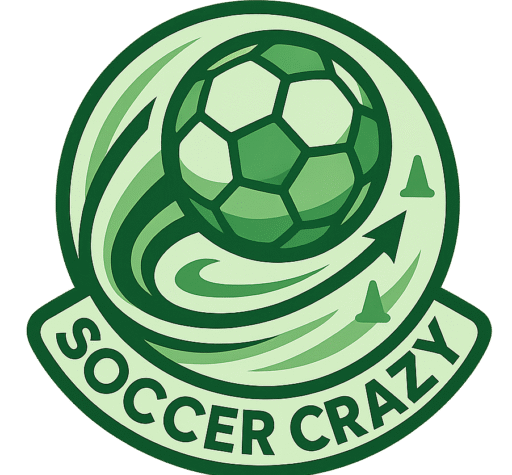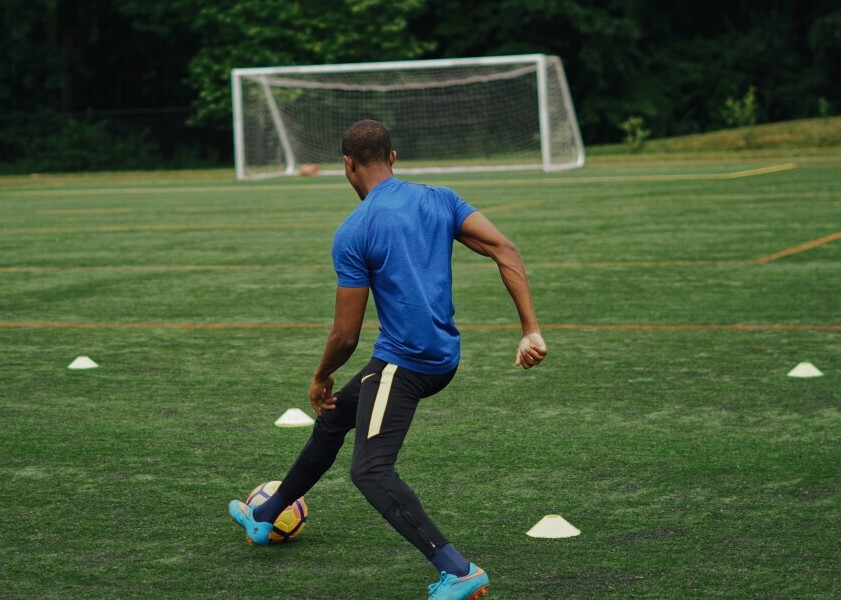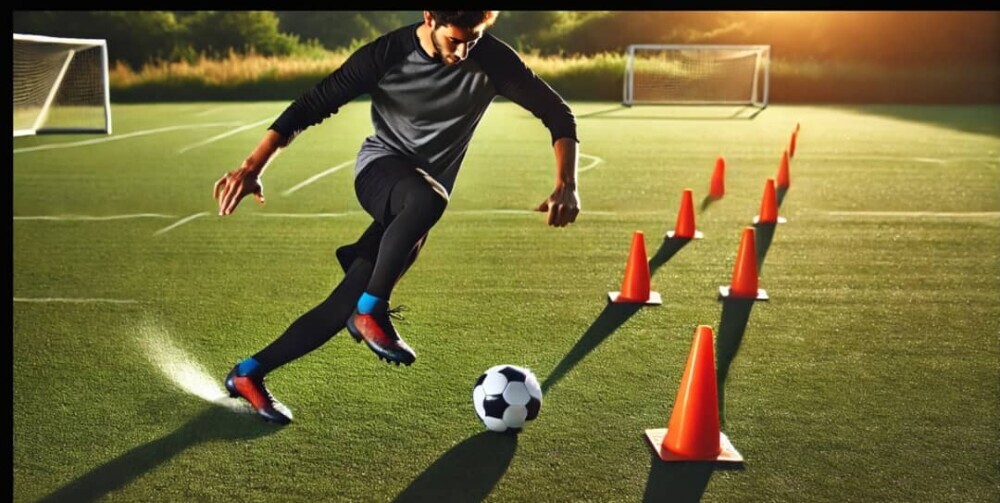Introduction to the Figure Eight Dribbling Drill:
The Figure Eight Dribbling Drill is an effective exercise designed to enhance a player’s ball control, precision, and agility.
By weaving through a set pattern, players can improve their ability to maneuver in tight spaces and develop a greater sense of spatial awareness.
This drill is particularly useful for refining quick direction changes and maintaining close control of the ball.
Setting Up the Drill:
- Equipment Needed:
- Soccer ball
- Two cones or markers
- A flat, open space (such as a soccer field or training ground)
2.Setup Instructions:
- Place the two cones about 5 meters (16 feet) apart. Adjust the distance based on the player’s skill level—closer for more challenge and wider for beginners.
- Ensure the cones are firmly placed to prevent them from moving during the drill.
Executing the Figure Eight Dribbling Drill:
- Starting Position:
-
- Begin at one of the cones with the soccer ball at your feet.
- Stand with a balanced posture, knees slightly bent, and ready to move.
- Dribbling Through the Cones:
- Figure Eight Pattern: Dribble the ball around the two cones in a figure-eight pattern. This means you will be making continuous, tight turns around the cones.
- Using Both Feet: Use both the inside and outside of your feet to maneuver the ball around the cones. Focus on alternating touches to develop ambidextrous dribbling skills.
- Sharp Turns: As you approach each cone, make sharp turns to navigate around it. Use the inside of your foot to push the ball past the cone and the outside of the opposite foot to continue towards the next cone.
- Close Control: Keep the ball close to your feet with small, controlled touches. This helps in maintaining control during quick changes of direction.
- Maintaining Control:
- Head Up: Keep your head up as much as possible to simulate game scenarios where you need to be aware of your surroundings while dribbling.
- Body Positioning: Maintain a low center of gravity by bending your knees and leaning slightly forward. This stance helps in making quick adjustments and staying balanced.
- Light Touches: Use light, frequent touches to maneuver the ball. Avoid heavy touches that can cause the ball to stray away from your path.
Advanced Variations:
- Increase Speed:
-
- Gradually increase the speed at which you dribble through the figure-eight pattern while maintaining control. This adds an element of intensity and helps simulate game conditions.
- Single-Foot Dribbling:
- Focus on dribbling through the cones using only your dominant foot. Repeat the drill using only your non-dominant foot to improve weaker foot skills.
- Combination Moves:
- Add dribbling moves such as step-overs, scissors, or feints as you maneuver through the cones. This encourages creativity and helps in practicing deceptive moves to beat defenders.
Common Mistakes to Avoid:
- Over-Reliance on Dominant Foot:
-
- Avoid using only your dominant foot. Ensure you’re developing skills in both feet for balanced dribbling ability.
- Looking Down at the Ball:
- Constantly looking down at the ball can hinder your awareness of the field. Practice keeping your head up to improve field vision.
- Heavy Touches:
- Heavy touches can cause loss of control. Focus on keeping touches light and close to your feet.
Benefits of the Figure Eight Dribbling Drill:
- Improved Agility and Balance:
-
- The quick changes of direction improve your overall agility and balance, making you more adept at sudden movements during games.
- Enhanced Ball Control:
- Regular practice enhances your ability to control the ball in tight spaces, crucial for navigating through defenders.
- Increased Confidence:
- Mastering this drill boosts your confidence in dribbling and handling the ball under pressure, translating to better performance on the field.
Incorporating the Drill into Your Training Routine:
- Warm-Up: Use the figure eight dribbling drill as part of your warm-up to get your muscles engaged and ready for more intense training.
- Consistent Practice: Integrate this drill into your regular training routine, aiming for at least 10-15 minutes per session.
- Progress Tracking: Record your progress, noting improvements in speed and control. Challenge yourself to reduce the time taken to complete the drill while maintaining precision.
FAQs
- What is the Figure Eight Dribbling Drill?
-
- Answer: The figure eight dribbling drill involves dribbling the ball around two cones or markers placed a few yards apart, forming a figure-eight pattern. This drill helps players improve their precision, agility, and ball control.
- Why is the Figure Eight Dribbling Drill important?
- Answer: This drill is crucial for developing a player’s ability to maneuver the ball with precision and agility. It enhances dribbling skills, footwork, and the ability to change direction quickly while maintaining control of the ball.
- How do I set up the Figure Eight Dribbling Drill?
- Answer: Place two cones or markers about 5-10 yards apart. Dribble the ball in a figure-eight pattern around the cones, focusing on tight control and sharp turns. Adjust the distance between the cones based on the player’s skill level.
- What are the key techniques to focus on during the Figure Eight Dribbling Drill?
- Answer: Focus on using both the inside and outside of your feet to dribble. Keep the ball close to your feet, maintain a low center of gravity, and use quick, controlled touches. Look up periodically to increase awareness of your surroundings.
- How can I vary the Figure Eight Dribbling Drill to make it more challenging?
- Answer: To increase the difficulty, reduce the distance between the cones, increase the speed of the drill, or use only one foot to dribble. You can also incorporate timing elements or perform the drill with a partner to add pressure.
- What common mistakes should I avoid during the Figure Eight Dribbling Drill?
- Answer: Common mistakes include taking large touches that are hard to control, not using both feet, looking down at the ball too much, and not maintaining a consistent pace. Focus on smooth, controlled movements and keep your head up as much as possible.
- How often should I practice the Figure Eight Dribbling Drill?
- Answer: For optimal results, incorporate the figure eight dribbling drill into your training routine 2-3 times a week. Consistent practice will help reinforce the skills and improve your overall dribbling ability.
- Can the Figure Eight Dribbling Drill be adapted for team practice?
- Answer: Yes, this drill can be adapted for team practice by setting up multiple figure eight courses and having players compete against each other in relay races or timed challenges. This encourages a competitive spirit and adds variety to the training session.
- What are the benefits of mastering the Figure Eight Dribbling Drill?
- Answer: Mastering this drill improves your ability to control the ball in tight spaces, enhances your dribbling speed and accuracy, and boosts your confidence during matches. It also helps in developing better coordination and balance.
- How can younger players benefit from the Figure Eight Dribbling Drill?
- Answer: Younger players can benefit by developing foundational dribbling skills early on. This drill helps them understand the importance of close ball control, agility, and precision, which are essential for their growth as soccer players.
- Are there any specific tips for advanced players practicing the Figure Eight Dribbling Drill?
- Answer: Advanced players should focus on incorporating more complex moves, such as quick step-overs, tight turns, and changes of direction. They should also practice at higher speeds to simulate game conditions and improve their reaction time.
- How does the Figure Eight Dribbling Drill improve a player’s overall game performance?
- Answer: By enhancing precision, agility, and the ability to change direction quickly, players can navigate through defenders more effectively, maintain possession under pressure, and create more scoring opportunities. This drill also helps in building muscle memory for better ball-handling skills during matches.
Conclusion
The Figure Eight Dribbling Drill is a versatile and effective exercise that forms the foundation of excellent ball-handling skills.
By consistently practicing this drill, you’ll develop superior control, agility, and confidence, crucial attributes for any soccer player.
Whether you’re preparing for a match or simply looking to improve your dribbling, this drill is an essential component of your training arsenal.
If you need further clarification on you have any questions, please leave them in the comment section below and I promise to get back to you.
Happy training.



Great article! I love how the Figure Eight Dribbling Drill emphasizes precision and agility, which are key for tight ball control in real-game scenarios. One question I have is about the distance between the cones—how would you recommend adjusting the spacing for younger players who might struggle with sharp turns? Also, do you have any tips for keeping control when increasing speed during the drill? Thanks for the detailed breakdown, I’m excited to try this drill with my team!
Thank you so much , Jonelle for your kind words and for taking the time to engage with the article!
I’m thrilled to hear that you found the Figure Eight Dribbling Drill useful and are excited to try it with your team.
Precision and agility really do make a difference in tight spaces, so this drill is perfect for developing those skills.
To answer your question about adjusting the spacing for younger players, I’d recommend starting with a distance of about 3-4 yards (2.5-3.5 meters) between the cones.
This allows for smoother, less aggressive turns, which makes it easier for younger players to build confidence with the drill.
As they get more comfortable, you can gradually reduce the distance to 2-3 yards to introduce sharper turns and better ball control.
As for maintaining control at higher speeds, one tip is to remind players to keep their touches light and frequent. The key is to use the inside and outside of both feet to guide the ball smoothly through the turns.
It also helps to encourage them to keep their eyes up when possible—this helps them maintain awareness of their surroundings, just like in a game situation.
Another strategy is to have them start slow and gradually increase their speed with each repetition. This way, they can focus on mastering control first before building up to game-speed dribbling.
Thanks again for your thoughtful questions!